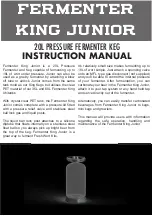
where at least two currents (phase current and/or residual current) shall be high for breaker
failure detection.
•
The current detection level for the residual current can be set different from the setting of
phase current detection.
•
It is possible to have different backup time delays for single-phase faults and for multi-phase
faults.
•
It is possible to have instantaneous back-up trip function if the circuit breaker is incapable to
clear faults, for example, at low gas pressure. This will happen when input signal 52FAIL has
logical value one and timer
tCBAlarm has expired. This situation will be indicated via output
signal CBALARM.
The selection of measurement criterion is done with setting parameter
FunctionMode, to
determine if the breaker has opened or not:
•
Option1 - Current: Compares the measured phase current magnitude to setting IPPU(operate
phase current level in % of
IBase), and the measured residual current magnitude to setting IN>
(Operate residual current level in % of
IBase). Criterion is active (i.e. breaker did not open yet)
if the measured current magnitudes are higher than the set values.
•
Option 2 - CB Pos: This criterion is active (i.e. breaker did not open yet in phase Lx) if the
binary input CBCLDLx has logical value one. Thus function simply follows the status of CB pole
normally open auxiliary contact (i.e. "52a" or "closed") which shall be connected to this input.
•
Option 3 - Current or CB Pos: It uses a combination of Current or CB Pos criteria. Note that
Current criterion will be then always used, while the CB Pos criterion will be only enabled and
used if current is smaller than set value
I>BlkCBPos at the moment when external INITIATE
signal has been received. It is recommended to set value for
I>BlkCBPos higher than the set
value for
IPPU.
By the setting
StartMode it is possible to select how t1 and t2 timers are run and consequently
how output commands are given from the function:
•
Option 1 - LatchedStart: “By external start signals which is internally latched”.
When function is once started by external INITIATE signal, the timers
t1 and t2 will always
elapse and then measurement criterion defined by parameter
FunctionMode will be always
checked in order to verify if the appropriate command shall be given out from the function.
Timers cannot be stopped by removing the external INITIATE signal. Function can be started
again only when all of the following three timers
t1, t2 and fixed timer of 150 ms in function
internal design has expired and the measurement criterion defined by parameter
FunctionMode has been deactivated, see
•
Option 2 - FollowStart: “Follow the external start signal only”.
The timers
t1 and t2 will run while external INITIATE signal is present. If they elapse then
measurement criterion defined by parameter
FunctionMode will be checked in order to verify
if the appropriate command shall be given out from the function. Timers can be always
stopped by resetting the external INITIATE signal, see
.
•
Option 3- FollowStart&Mode: “Follow external start signal and selected FunctionMode”.
The timers
t1 and t2 will run while external INITIATE signal is present and in the same time the
measurement criterion defined by parameter
FunctionMode is active. If they elapse then the
appropriate command will be given out from the function. Timers can be stopped by resetting
the external INITIATE signal or if the measurement criterion de-activates, see
Section 8
1MRK 502 066-UUS B
Current protection
528
Technical manual
Summary of Contents for Relion 670 series
Page 1: ... RELION 670 SERIES Generator protection REG670 Version 2 1 ANSI Technical manual ...
Page 2: ......
Page 48: ...42 ...
Page 62: ...56 ...
Page 182: ...176 ...
Page 692: ...686 ...
Page 726: ...720 ...
Page 1014: ...1008 ...
Page 1242: ...1236 ...
Page 1362: ...1356 ...
Page 1386: ...1380 ...
Page 1422: ...1416 ...
Page 1431: ...1425 ...
















































